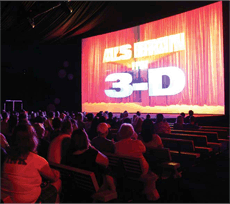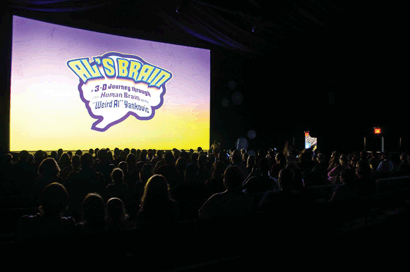Harkness Screens Provides a 3D Look Inside “Al’s Brain”
When Gary Hardesty, director at Sound Media Fusion, was mandated with designing the traveling production of “Al’s Brain — A 3D Journey through the Human Brain with Weird Al Yankovic,” he knew he was in for a challenge. The project would mark the first time a 3D exhibit would be made portable so that the entire building and everything inside of it could be taken on the road.
Sound Media Fusion was mandated with designing the traveling production of “Al’s Brain — A 3D Journey through the Human Brain with Weird Al Yankovic.”
Written, produced, directed by, and starring Yankovic, “Al’s Brain,” which made its world premiere at the Orange County Fair in August, is a $2.5 million travelling exhibit that combines both live action and 3D animation that comes together in a 10-minute film culminating with Yankovic’s first computer- generated music video for a new song called “The Brain Song.”
The goal of “Al’s Brain” was to provide the best 3D experience possible with a large-scale traveling production. Since this exhibit was the first of its kind, Hardesty and his team were creating the protocol as they worked on the project. “Having never done something like this before, it was essential to the success of the show that we got everything right during the planning stage,” says Hardesty. “We were writing the instruction manual as we went.”
As an all encompassing travelling exhibit, even the building structure is state-of-the-art. The building that houses “Al’s Brain” is actually a hardwalled tent and is the first of its size and type in the world. “The tent consists of four separate rooms including the Brainitorium, pre-show lobby, and post-show store,” says Hardesty. “If you look at it, you wouldn’t know it is a tent. “It looks like a permanent structure but it’s not. The theater is quite elegant with a lot of black drapery.”
With a seating capacity of 500, “The Brainitorium” features a 40-foot x 22- foot Harkness Spectral 240 mini perf 3D curved screen that takes viewers on a 3D tour through the human brain, featuring Yankovic as the twisted tour guide.
“I chose Harkness’s Spectral 240 3D Screen because of the product quality, the company’s customer service, and the willingness of Harkness to meet our demands for a large screen in a very short time period,” says Hardesty. “I compared what Harkness had to offer versus other companies and knew that Harkness was the choice to make this unique production come to life.”
Not only was screen selection important to the success of the show, so was screen preservation. “Whenever you are working with a live production, you are always worried about problems during the set-up and take-down process,” continues Hardesty. “Working with a screen as large as the Harkness Spectral 240, we needed to make sure we could safely and securely transport it from venue to venue. We quickly learned how to install the screen structure in sections as it occupies the entire height of the tent. Thanks to careful planning, the installation of the screen turned out to be quite easy even with all of our restrictions in the portable building. The screen works phenomenally.”
Hardesty and his team also learned how to manage the screen material in less than desirable circumstances. Since the portable theater is far from the ideal environment to deploy a screen, Hardesty used special plastics to protect the screen on the ground before it was safely installed.

With a seating capacity of 500, “The Brainitorium” features a 40-foot x 22-foot Harkness Spectral 240 mini perf 3D curved screen that takes viewers on a 3D tour through the human brain, featuring Yankovic as the twisted tour guide.
Adding Depth
To create the highest standard of 3D animation possible, Weird Al employed 3D expert and director of photography, Peter Anderson. With over 30 years of industry experience, Anderson is widely recognized as one of the world’s leading experts in 3D production and exhibition. He has played a key role in more than 50 special venue and/or large-format 3D projects, over 40 feature films, and hundreds of hours of prime time television. “It is incredible to see what Peter and Weird Al have been able to create,” adds Hardesty. “This film takes the 3D viewing experience to the next level.”
According to Hardesty, “I think our biggest challenge on this project was equipment selection. “When you go into a traveling production like “Al’s Brain,” proper equipment selection is vital. You have to think of portability and reliability of your equipment more than anything else.”
For the video playback server for the main room, Hardesty chose an Electrosonic ES 9600 for its ability to play dual channels of video for 3D plus 16 channels of audio, which the project calls for. The Peavey MediaMatrix provided the distribution and equalization for all of the JBL speakers. The projectors used are Christie, and a Medialon control system helps automate a lot of the systems used in the production.
“Al’s Brain” speaks well to the future of portable 3D entertainment. Hardesty and his team were able to create a system that was extremely flexible and fairly small in terms of the amount of electronics involved. The self-powered speakers eliminated the need for amplifiers and equipment that would have needed to be used around the venue. “We have successfully created the protocol for doing a complex traveling multi-venue 3D theater show,” continues Hardesty. “We’ve proven it can be created and moved. We’ve also demonstrated that a screen of this size can handle the rigors of a traveling production.”
“Al’s Brain” will continue to make its way around the country and could potentially make its international debut at the 2010 World Expo in Shanghai, China.
